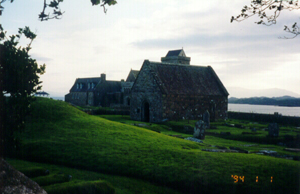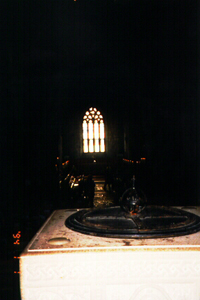|
Recovery in the thirteenth
century: The Benedictine Abbey
 The Abbey
The Abbey
Monastic life died down on Iona after these tumultuous events, and
was not revived until 1200 when the Benedictines rebuilt the abbey.
The founder was Reginald son of Somerled, the same man who founded the
nunnery. During this time, many noble families patronized the abbey
and were buried in the Relig Odhrain. The most important of these
nobles were the MacDonald Lords of the Isles, who were descendants of
Reginald; the fourth and last MacDonald Lord of the Isles may be the
person whose tomb recess tomb recess is in St. Oran's Chapel.
 The
oldest building on the grounds dating from this period is the Chapel
Oran. According to tradition, Oran (Adhrain) was Columba's cousin and
was sacrificed and buried by Columba to sanctify the island. There is
very little evidence to corroborate this tradition. The
oldest building on the grounds dating from this period is the Chapel
Oran. According to tradition, Oran (Adhrain) was Columba's cousin and
was sacrificed and buried by Columba to sanctify the island. There is
very little evidence to corroborate this tradition.
Parts of the abbey, including the choir, tower, and nave, were rebuilt
again in 1450 by Abbot Dominic.
 The
Nave was extensively rebuilt in 1910, following the design of P. MacGregor
Chalmers. The transepts are the only remaining parts of the original
Benedictine abbey. The
Nave was extensively rebuilt in 1910, following the design of P. MacGregor
Chalmers. The transepts are the only remaining parts of the original
Benedictine abbey.
The Cloister
Many
columns, however, were recarved with beautiful designs.
Jacques Lipchitz Sculpture
The Bishop's House
The Michael Chapel
The High Crosses at the Abbey
Iona was also home, for a period, to a community of Augustinian canonesses.
In 1200, the same Reginald son of Somerled, who had founded the abbey,
also founded a house for women on the island.
 Continue to the next page to read the history of
the Augustinian nunnery. Continue to the next page to read the history of
the Augustinian nunnery.
 Return to the Index of Iona: A Virtual Tour Return to the Index of Iona: A Virtual Tour
 Return
to the Index of Celtic Monasticism: History and Spirituality Return
to the Index of Celtic Monasticism: History and Spirituality
|


